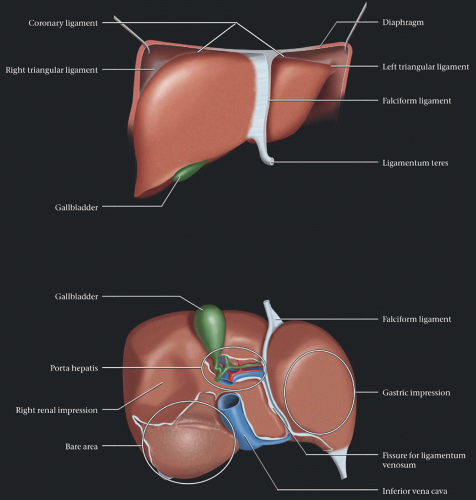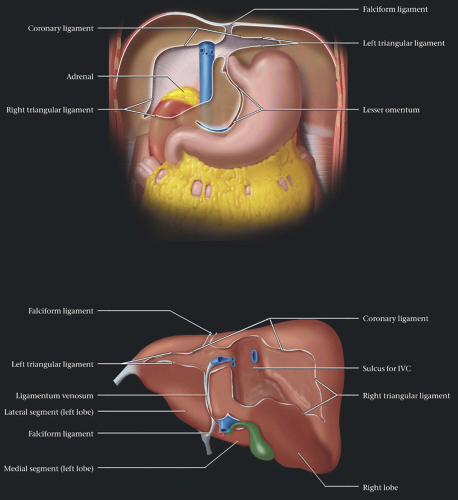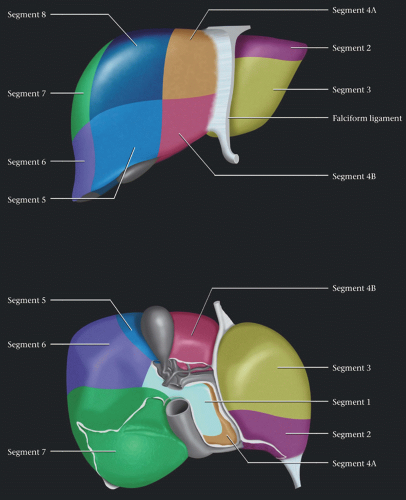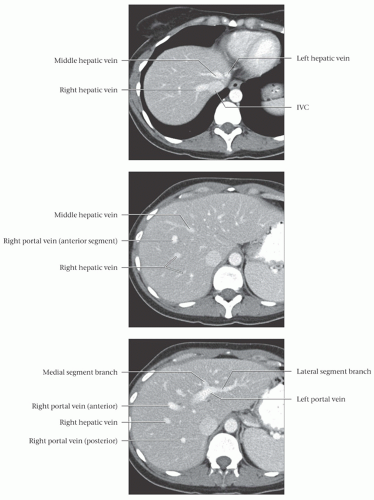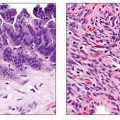Liver Anatomy
Michael P. Federle, MD, FACR
GROSS ANATOMY
Overview
Largest gland & largest internal organ (average weight = 1,500 grams)
Functions
Processes all nutrients (except fats) absorbed from GI tract; conveyed via portal vein
Stores glycogen, secretes bile
Relations
Anterior & superior surfaces are smooth and convex
Posterior & inferior surfaces are indented by colon, stomach, right kidney, duodenum, IVC, and gallbladder
Covered by peritoneum except at gallbladder fossa, porta hepatis, and bare area
Bare area: Nonperitoneal posterior superior surface where liver abuts diaphragm
Porta hepatis: Site of entry/exit of the portal vein, hepatic artery, and bile duct
Falciform ligament: Extends from liver to anterior abdominal wall
Separates right & left subphrenic peritoneal recesses (between liver & diaphragm)
Marks plane separating medial and lateral segments of left hepatic lobe
Carries round ligament (lig. teres), fibrous remnant of umbilical vein
Vascular supply (unique dual afferent blood supply)
Portal vein
Carries nutrients from gut and hepatotrophic hormones from pancreas to liver along with oxygen (contains 40% more oxygen than systemic venous blood)
75-80% of blood supply to liver
Hepatic artery
Supplies 20-25% of blood
Liver is less dependent than biliary tree on hepatic arterial blood supply
Usually arises from celiac artery
Variations are common, including arteries arising from superior mesenteric artery
Hepatic veins
Usually 3 (right, middle, and left)
Many variations & accessory veins
Collect blood from liver and return it to IVC at confluence of hepatic veins, just below diaphragm and entrance of IVC into heart
Portal triad
At all levels of size and subdivision, branches of hepatic artery, portal vein, and bile ducts travel together
Blood flows into hepatic sinusoids from interlobular branches of hepatic artery & portal vein → hepatocytes (detoxify blood and produce bile) → bile collects into ducts, blood collects into central veins → hepatic veins
Segmental anatomy of liver
8 hepatic segments
Each receives secondary or tertiary branch of hepatic artery and portal vein
Each is drained by its own bile duct (intrahepatic) and hepatic vein branch
Caudate lobe = segment 1
Has independent portal triads and hepatic venous drainage to IVC
Left lobe
Lateral superior = segment 2
Lateral inferior = segment 3
Medial superior = segment 4A
Medial inferior = segment 4B
Right lobe
Anterior inferior = segment 5
Posterior inferior = segment 6
Posterior superior = segment 7
Anterior superior = segment 8
ANATOMY IMAGING ISSUES
Questions
Designating and remembering hepatic segments
Portal triads are intrasegmental; hepatic veins are intersegmental
Separating right from left lobe
Plane extends vertically through gallbladder fossa & middle hepatic vein
Separating right anterior from posterior segments
Vertical plane through right hepatic vein
Separating left lateral from medial segments
Plane of falciform ligament (fissure of ligamentum teres)
Separating superior from inferior segments
Plane of main right & left portal veins
Segments are numbered in clockwise order as if looking at anterior surface of liver
Imaging Pitfalls
Because of variations of vascular & biliary branching within liver (common), it is frequently impossible to precisely designate boundaries between hepatic segments on imaging studies
CLINICAL IMPLICATIONS
Clinical Importance
Advances in hepatic surgery (tumor resection, transplantation) make it essential to depict lobar and segmental anatomy, volume, blood supply, and biliary drainage as accurately as possible
Combination of axial, coronal, sagittal, and 3D imaging by CT, MR, and sonography may be needed
“Invasive” imaging studies (catheter angiography and percutaneous transhepatic or endoscopic cholangiography) can be avoided in many cases by CT & MR angiography and cholangiography
Liver metastases are common
Primary carcinomas of colon, pancreas, & stomach are common
Portal venous drainage usually results in liver being initial site of metastatic spread from these tumors
Primary hepatocellular carcinoma
Common worldwide; usually result of viral hepatitis B or C, alcoholism
Image Gallery
HEPATIC VISCERAL SURFACE
HEPATIC ATTACHMENTS AND RELATIONS
HEPATIC VESSELS AND BILE DUCTS
HEPATIC SEGMENTS
AXIAL CT, NORMAL LIVER
AXIAL CT, NORMAL LIVER
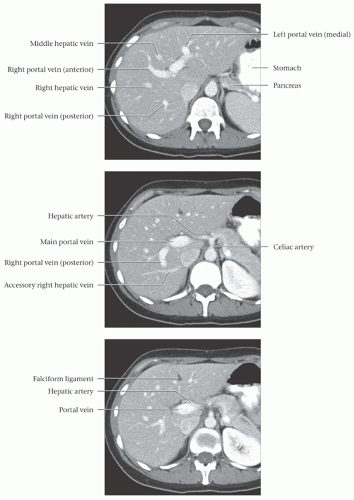 (Top) The plane of section through the long axis of the right portal vein divides segments 7 & 8 (above) from segments 5 & 6 (below). Note the relations between the liver, stomach, and pancreas. (Middle) In this subject, the hepatic artery arises conventionally from the celiac artery. There is an accessory right hepatic vein that drains directly into the IVC, caudal to the confluence of the other hepatic veins. This accessory vein may have important implications in the setting of partial liver resection or transplantation. (Bottom) Note the fissure for the falciform ligament (ligamentum teres), which separates the medial and lateral segments of the liver (segment 4 from segments 2 and 3).
Stay updated, free articles. Join our Telegram channel
Full access? Get Clinical Tree
 Get Clinical Tree app for offline access
Get Clinical Tree app for offline access

|
